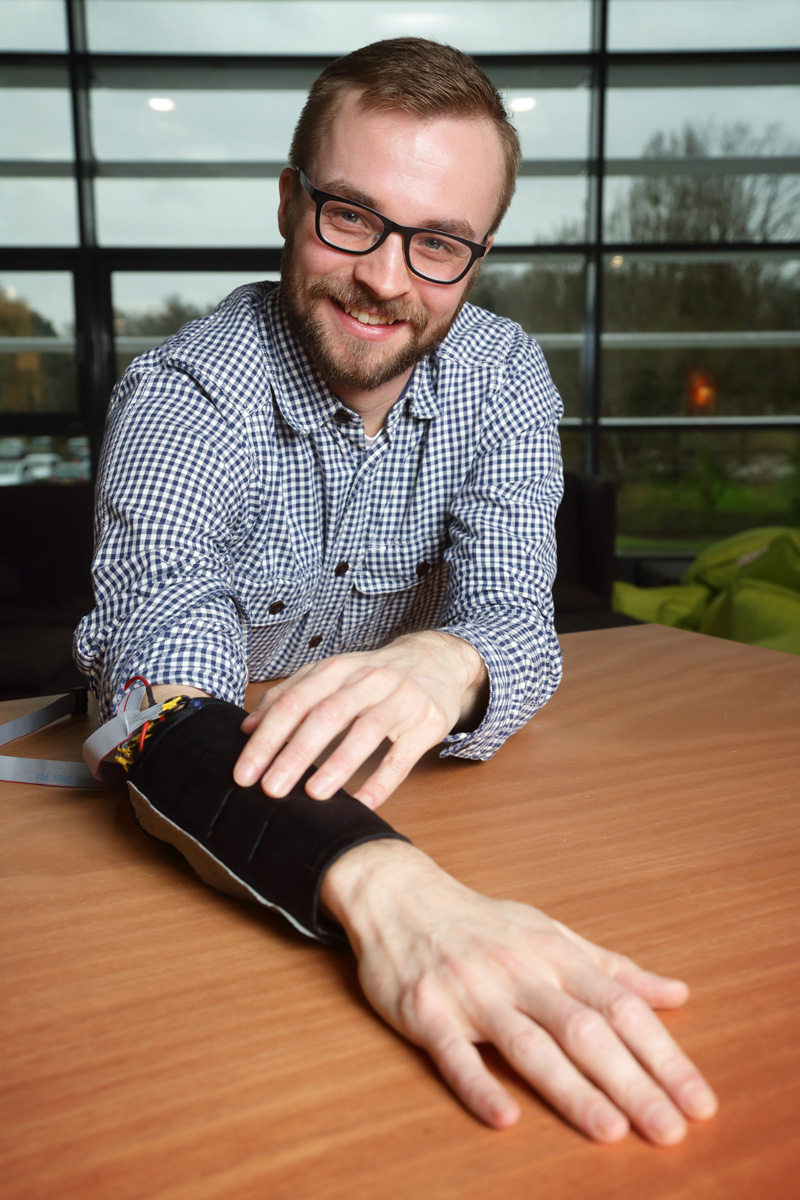Extending the reach of social touch through haptic technology
The skin not only protects the body from harm but, through receptors found in the skin, also enables the sense of touch. The sense of touch is used to obtain information about the world outside the body, for example, the shape and weight of a book or the texture of its cover. However, the sense of touch also has an important affective function that becomes clearly apparent in social touch interactions such as hugging someone or stroking someone’s back.

Gijs Huisman is PhD candidate at the Human Media Interaction Group of the University of Twente, working on Social Touch Techology.
Social touch plays a vital role in the physical, cognitive, and emotional development of infants, can have positive effects on a person’s well-being, can affect attitudes and behaviors towards the toucher, and is important in the communication of affect and emotions. Despite its importance in interpersonal communication social touch capabilities are lacking in current communication technology. Therefore, here, through a thorough discussion of a large body of literature, and several studies, a broad perspective on haptic technology for social touch interactions, referred to here as social touch technology, is provided.
The Tactile Sleeve for Social Touch (TaSST) was developed to enable research into mediated social touch by allowing two individuals to engage in social touch at a distance by touching their own forearm. In an iterative design process several versions of the TaSST were developed, all featuring a fabric touch-sensitive input layer and an output layer consisting of vibration motors. In a first explorative study it was found that participants mainly touched the TaSST by poking or pressing its surface. The second TaSST featured a redesigned input and output layer and was used in a study into emotional expression through touch. It was found that while participants did use socially relevant touches to express emotions, sensor data did not show clear patterns in the expressions. The final version of the TaSST was developed in collaboration with caregivers of people with congenital deafblindness to explore possibilities for extending their clients’ communication capabilities.
Work on the type of vibrotactile feedback produced by the TaSST was extended by investigating a vibrotactile apparent motion illusion. This apparent motion illusion can be described as ‘vibrotactile stroking’. It was found that pleasantness judgments of vibrotactile stroking sensations followed a velocity-dependent inverted u-curve similar to that found for pleasantness judgments of actual stroking touches. Further investigation focussed on observed stroking touches at different velocities and applied by a human hand or by objects with varying levels of human likeness. It was found that stroking velocity was the most important determinant of pleasantness judgements and that these judgements again followed a velocity-dependent inverted u-curve similar to that found for felt stroking touches.
Visuo-tactile social touch was implemented in a touching virtual agent system. In the first design participants wore a vibrotactile display on their forearm and observed their arm through an augmented reality display. Participants could thus see and feel touches from a virtual agent whose upper body was visible on a computer monitor. The touching virtual agent setup inspired a study in which participants wore vibrotactile displays on their arms and used a hand-held augmented reality display to look around the room in which two virtual agents were present. One virtual agent applied casual social touches to the participant’s upper arm during a collaborative or competitive game. It was found that, independent of the type of game, touches by the virtual agent enhanced feelings of social presence and made the virtual agent seem to have a warmer personality.
The work presented here offers insights into the design of devices for mediated social touch, stresses the importance of multimodal cues in touch perception, and provides suggestions for the implementation of social touch capabilities in augmented reality virtual agent systems.





